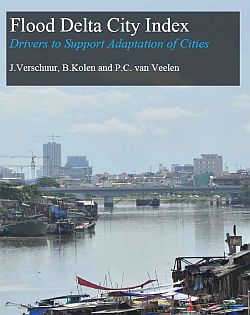Report: Flood Delta City Index, Drivers to Support Adaptation of Cities
Towards a flood delta city index Globally, there is an increasing recognition that processes of urbanisation and economic growth surpass the effects of climate change as main source of risk.
Projections for the year 2050 predict a total population of 650 million people living in delta areas. Due to climate change, socioeconomic growth, land subsidence and (uncontrolled) urbanisation, delta areas will face a steep incline in flood risk and become vulnerable to the effects of flooding. Not surprisingly, combatting flood risk and climate change and its impacts is one of the key aspects in the United Nations Sustainable Development Goals. These global commitments also urge the development of clear indicators and practical tools to measure progress.
To help decision makers in delta areas to select appropriate adaptation and mitigation strategies it is necessary to have a clear picture of the main sources of risk and how this risk evolves under changing conditions. Because flood risk is often considered an urgent but almost never acute problem, it is difficult to keep flood risk on the investment agenda. Acknowledging these problems, the Delta Alliance and the TU Delft took the initiative to develop a new index that helps cities to better understand the dominant drivers of risk, formulate ambitions, and compare and share their results with other delta regions. The approach is based on previous work at TU Delft in collaboration with HKV and Deltares. The rankings goal is not to formulate an “exact” risk number, but aims to serve as a benchmark that supports the discussion and supports a peer learning process with other deltas. And that helps to better communicate risk within the political arena.
What does it do?
The Flood Delta City Index is complementary to existing qualitative risk assessments and indices that are developed mainly within academia. These flood indices are often qualitative, time-intensive to produce and risk a problem of subjectivity. Also, many resilience-based or adaptability-based indices do not distinguish between quantitative (flood) risk and qualitative indicators, such as socio-economic data or governance aspects that may positive influence future risk, making it difficult to clearly assess and compare flood risk.
Based on a literature review (see report) a number of key principles were selected. The index should be easily reproducible to allow a quick and low-cost assessment that can be reproduced regularly. For this reason it was decided to work with open data and open algorithms. In addition, The Flood Delta City Index focuses on flood risk as a central parameter, in which risk is defined as probability x consequences. This creates an opportunity to analyse a large amount of cities in a relative short time and cost efficient manner. Secondly, the index should be ready for, or partly based on self-assessment. This helps cities to manage the information and data gap, but it will also stimulate the development of new data.
The index consists of three levels:
- First, the quantified risk is assessed for the current situation and for two future scenarios based on climate change and socio-economic development by 2030. Both probability of flooding as economic damage and victims are taken into account.
- Secondly, the risk is mapped on a risk rose that describes various related parameters. These parameters follow the philosophy of the multilayer safety principle in which its “layers” of prevention, spatial adaptation and disaster management.
- Finally, the combined flood risk and expected future risks is graphically presented with an "alarm coding". This parameter is intended to function as a benchmark with other delta cities and to stress the urgency.
First results
To test the proposed approach, a first ranking of 38 delta and coastal cities has been prepared. For practical reasons, the flood risk assessment is limited to coastal flooding and given data limitations not all Delta Alliance cities could be included. The list is dominated by the world's mega cities, leading by Buenos Aires. Looking at future risk scenarios, Asian cities in particular will face a strong increase in risk due to ongoing urbanisation and further economic growth. This contrast with Japan's cities Tokyo and Osaka, who show more stable risk number due to the expected stagnant economic growth. Especially in the extreme scenario by 2030, cities of Tianjin, Taipei and Shanghai may expect a strong risk increase due to climate change. In terms of risk bridging between now and 2030, it is more interesting to look at cities that may not be in the top of the ranking but will experience explosive growth. One example is Dhaka who can expect a future increase of 4 to 9 times the current risk or Kolkata in India and Palembang in Indonesia with even more extreme projections.
Using the outcomes of this index, a city-specific factsheet has been prepared for each city. These factsheets serve as a “dashboard” and as a means of communication to inform city stakeholders and leaders.
Invitation for participation
The coming period the Delta City Index functionality will be further developed and tested. One of the shortcomings of using open data is that it generally lacks data that covers the scale of delta territory. This means that data is based only on information that is available for the metropolitan areas. To overcome this problem, in close collaboration with the Delta Alliance collaboration is sought with Delta Alliance Wings to test and improve the ranking. These delta regions are expected to provide basic information on topography, patterns of urbanisation and economic development and actively contribute to the ranking by performing a self-assessment. In return, the delta regions will receive an updated factsheet and assessment report.
Read more
- Full report: Flood Delta City Index, Drivers to Support Adaptation of Cities (2017) J.Verschuur, B.Kolen and P.C. van Veelen (TU Delft / Delta Alliance)
- Factsheet Buenos Aires
- Factsheet Guangzhou
For further information you can contact:
Peter van Veelen or Bas Kolen


